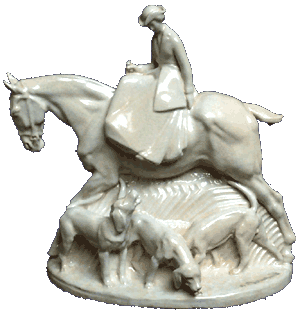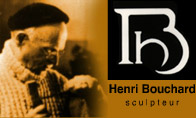Ceramics by Bouchard
14th October 2000 - 14th March 2001 extended to 16th September 2001
Exhibited for the first time, Bouchard's ceramics are little known and will shed new light on the sculptor's work, especially in contrast to his works in bronze and stone.
Henri Bouchard (1875 – 1960) was first and foremost a modeller, so it is perfectly normal that he tried to make terracotta objects from a very early age.
Some allusions in the handwritten Mougin catalogue reveal six models by Bouchard, works made in his youth before his departure for Rome in 1901, which have never been found.
The information is highly plausible : the Mougin brothers, Joseph (1876 – 1961) and Pierre (1880 – 1955) were ceramists in Paris until 1906 when they moved to Nancy.
Joseph Mougin and Bouchard were both pupils in Barrias's studio at the National School of Art, and later Bouchard taught Bernard, Joseph's son.
Two works from the end of the nineteenth century have been found.
They are original terracotta works modelled from one block, small scale works, the Hay maker, and Bacchus sitting on a barrel dated 1899 and dedicated to a merchant of good Burgundy wines.
These examples underline his interest at the time, but were not followed up.

Amazon
In 1924, for the Exhibition of Industrial and Decorative Arts in Paris in 1925, Bouchard agreed a contract with the Manufacture Nationale de Sèvres (porcelain factory) for a fountain ordered for the garden between the two wings of the factory in a group by the decorator Henri Rapin.
Placed on the esplanade of the Invalides, on the Seine side, this fountain was made up of four big low-reliefs in white ceramic, but unfortunately it disappeared in 1944 when the town of Lens, where it had been moved after the exhibition, was bombed. Only photographs remain to give us an idea of what it was like.
The experiment was very interesting.
Two studies are exposed, one in relief and the other a silhouette underlined by a deep groove; the latter was chosen to make the final form of the low reliefs, with perceptible but little emphasised contours of young women playing with an animal in a decorative stylisation of the scene well adapted to what was, for the artist, a new medium.
After the exhibition, the manager of the Lechevalier-Chevignard factory requested that Bouchard make some models so they could produce them as stoneware, or in porcelain, either dull biscuit or shiny enamel.
The contracts were signed between 1928 and 1932, except for the last one, Christ on the Cross, which was signed in 1936 but does not seem to have been used a great deal, only the contract has been found, but no ceramics.
Animals were a dominant theme in 1928 with three pieces for the table around the theme of hunting, the horse of the Lost Tracks accompanied by the Boar Brought to the Ground and the Wolf under Attack, the Hare, the Gazelle or the Little African Donkey and the Breton Horse.
The typical decorative innovations of the 1920s, with straight lines emphasising muscle, (the Hare) or the space filled in between the paws or hooves (the Hare, the Gazelle, the Little Donkey) show the enthusiasm with which Bouchard responded to the factory's wish to produce works by contemporary artists who were not ceramists themselves but accepted this new material which found favour in decorative sculpture.
Virgin and Child, the Sailors' wives, the Breton woman, or the Lost Tracks are less stylised works.
The Virgin and Child from the factory has been found in red or light coloured sandstone, however, Christ on the Cross has never been found.
At the same time Victor Canale produce some polychromatic ceramics of Bouchard's Stations of the Cross, but we have never found the whole series set up.
The Church of Sauchy-Lestrée in the Pas-de-Calais area contains the complete series embedded in the side walls of the church which can be seen through the molten glass cast by René Lalique in 1930.
This exhibition of around thirty ceramic sculptures presents a new and previously unknown side of Henri Bouchard's work, which reached its peak around 1928.
His interest in different materials that other exhibitions in the musée Bouchard have made apparent through an assortment of shades of stone, is illustrated again here with various white or coloured clays and numerous glazes.






